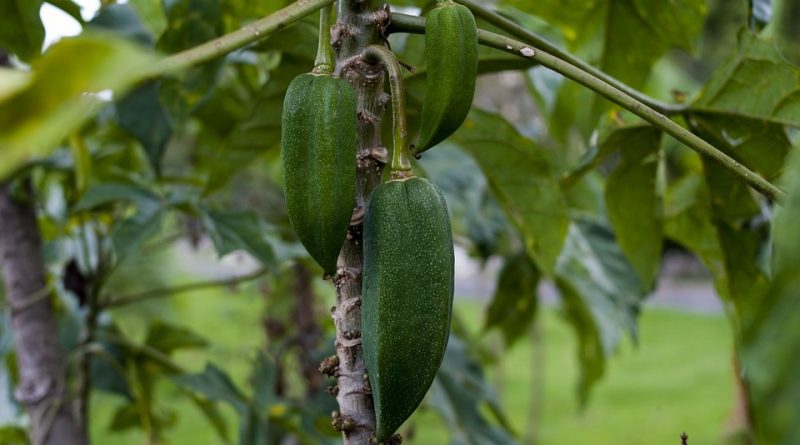Carica pentagona
Carica pentagona
The Babaco (Carica × pentagona Heilborn) is probably an intergeneric hybrid between Carica pubescens and Carica Stipulata which belongs to the family of the Caricaceae.
Systematics –
From the systematic point of view it belongs to the Eukaryota Domain, United Plantae, Magnoliophyta Division, Magnoliopsida Class, Brassicales Order, Caricaceae Family and therefore to the Genus Carica and the Species C. × pentagona.
The term Vasconcellea × heilbornii is synonymous.
Etymology –
The term Carica comes from the classical Latin, carĭca, fig of Caria and from the ancient Greek Καρία Caría, in Turkish Kariye, in Arabic karwija, belonging to Caria in Asia Minor, for the similarity of the leaves to this plant. the pentagonal epithet derives from the Greek πέντε pénte five and from γωνία gonía corner: with five angles or edges.The term Babaco comes instead from an entry of Ecuadorian origin.
Geographical Distribution and Habitat –
Babaco is a plant native to South America (Ecuadorian highlands) and is also cultivated in Australia, New Zealand and to a small extent in Italy. The plant prefers environments with temperatures between 6 and 30 ° C, humid and with frequent rains. The soil must be dry and free from water stagnation.
Description –
Carica × pentagona is classified as a herbaceous shrub that can reach up to 4-6 meters in height, although in cultivations it does not normally exceed 2 meters.
The plant has leaves with 5 lobes, with the central one in turn trilobed, glabrous, with long petiole and stipules of the spiny leaf base. The female holes are solitary, carried by short peduncles, of greenish color. The male ones in long pedunculated groups. The fruits are ellipsoid, with dimensions up to 50 cm. in length, with 5 prominent sides; these are yellowish, with white flesh and few or missing seeds.
It is a fast growing plant and leaves concentrated in the upper part.
Cultivation –
Babaco is a plant that multiplies easily by cutting, as the fruits often have no seeds. It needs soil moisture and exposure rather protected from intense sun. Its fruit is edible and cultivated in many parts of the world.
In Sicily it is grown under a cold greenhouse. It is sensitive to the salinity of irrigation water. The plants are planted in spring and need abundant irrigation and phospho-nitrogen fertilization. The production begins already in early summer and the fruits grow during the autumn-winter period and at the beginning of spring they enter the ripening phase which lasts for 3-4 months.
As regards the details of the cultivation technique, see the following sheet.
Uses and Traditions –
The Babaco plant, native to the mountain rainforests of the low Andes in Ecuador and Colombia, has been successfully cultivated in countries with a similar climate as New Zealand. With special precautions it is cultivated in the Channel Islands, in the United Kingdom and also in Italy. The fruit is particularly appreciated for human nutrition and recalls, in its overall appearance, a white melon, but with a typically pentagonal section (similar to a pepper).
When ripe, it has a yellow streaked green color and a flavor reminiscent of pineapple and orange; can reach a weight of 2 kg. The peel is thin and the seeds are almost always missing. Al Babaco is attributed anti-infective and digestive properties. Due to the high content of vitamin C it is an excellent antioxidant and enhances the immune system.
The nutritional values of Babaco, which has a low calorie content (only 21 kcal per 100 g of product) are mainly due to the content of vitamin A, C and mineral salts (especially calcium, phosphorus and iron).
Preparation Mode –
The pulp of the Babaco fruit is sub-acidic and refreshing and is normally consumed fresh, but also as a juice, compote and fruit paste.
The fruit is preserved very well and in the fridge for a long time. The pulp of Babaco, which is quite fibrous, is however consumed better blended with lemon and sugar; it is very refreshing, as well as Babaco sorbet and smoothie made with added lemon, sugar, water and ice. Even the peel is edible. It can be consumed naturally in a fruit salad with added cream or ice cream. The fruit can also be eaten unripe, seasoned with sauces such as curry or chatney, as a side dish for meat dishes.
Guido Bissanti
Sources
– Acta Plantarum – Flora of Italian Regions – Wikipedia, the free encyclopedia – Treben M., 2000. Health from the Pharmacy of the Lord, Advice and experiences with medicinal herbs, Ennsthaler Publisher – Pignatti S., 1982. Flora d ‘Italy, Edagricole, Bologna. – Conti F., Abbate G., Alessandrini A., Blasi C. (edited by), 2005. An annotated checklist of the Italian vascular flora, Palombi Editore.
Attention: Pharmaceutical applications and food uses are indicated for informational purposes only, do not in any way represent a medical prescription; therefore no liability is accepted for their use for curative, aesthetic or food purposes.


